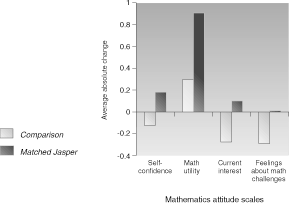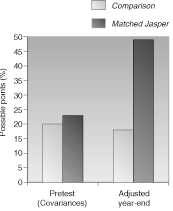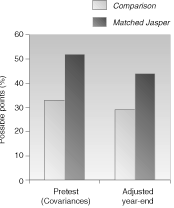BOX 9.2
Problem Solving and Attitudes
Students in classrooms in nine states received opportunities to solve
four Jasper adventures distributed throughout the year. The average
total time spent solving Jasper adventures ranged from 3 to 4 weeks.
The students were compared with non-Jasper comparison classes on
standardized test scores of mathematics, problems requiring complex
problem solving, and attitudes toward mathematics and complex
challenges. With no losses in standardized test scores, both boys and
girls in the Jasper classrooms showed better complex problem solving and
had more positive attitudes toward mathematics and complex challenges
(see Cognition and Technology Group at Vanderbilt, 1992; Pellegrino et
al., 1991).
The graphs show scores
for Jasper and comparison students on questions that asked them to (a)
identify the key data and steps needed to solve complex problems, (b)
evaluate possible solutions to these problems, and (c) indicate their
self-confidence with respect to mathematics, their belief in the utility
of mathematics, their current interest in mathematics, and their
feelings about complex math challenges. Figure 9.1 shows positive
attitude changes from the beginning to the end of the school year for
students in the interactive video challenge series, with negative
changes falling below the midline of the graph, as shown for most of the
students in the comparison groups. Figures 9.2 and 9.3 indicate
positive changes for Jasper-video students' planning skills growth and
comprehension on the problem-solving challenges. Clearly, the
interactive video materials had positive effects on children's problem
solving and comprehension.
|
|

|
FIGURE 9.1 Changes in attitude.
|
|
|

|
FIGURE 9.2 Top-level planning challenge.
|
|
|

|
FIGURE 9.3 Subgoal comprehension problems.
|